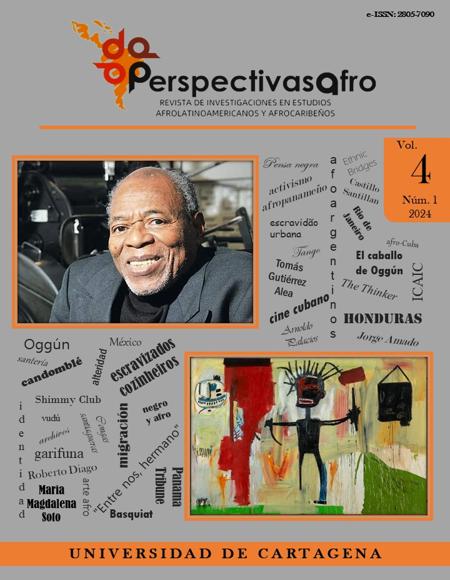Conflicto intergeneracional en la Cuba contemporánea: rivalidad dentro de las Congas Santiagueras
Intergenerational Conflict in Contemporary Cuba: Rivalry within Las Congas Santiagueras
Contenido principal del artículo
Resumen
The current article reflects on the topic of intergenerational conflict between those Cubans who lived closer to the beginning of the Castro-led Revolution of 1959, and those who were born closer to the beginning of the 1990s, during the fall of the Soviet Union, now referred to as the Special Period in the Time of Peace. In the documentary Lázaro and the Shark: Cuba under the Surface (2022), Cuban exile director William Sabourin O'Reilly showcases this national conflict. Through the screen, O’Reilly highlights the beauty of the Afro-influence combined with the intimate and lively rivalry between Santiago’s local Conga groups in a country riddled by harsh conditions to dive deeper into the ever-growing intergenerational conflict. Within this current conflict, Cuba’s generations are separated into Fidelists and Oppositionalists; in opposition to the Pragmatist and the Disengaged generation (Krull and Kobayashi). With recent restrictive legislation for Cuban filmmakers, the director’s ability to make a controversial documentary of this nature is only possible from outside of Cuba as an exile.
Descargas
Datos de publicación
Perfil evaluadores/as N/D
Declaraciones de autoría
Indexado en
- Sociedad académica
- Universidad de Cartagena
- Editorial
- Universidad de Cartagena
Detalles del artículo
Referencias (VER)
Bettelheim, Judith. “Ethnicity, Gender, and Power: Carnaval in Santiago de Cuba”. Negotiating Performance: Gender, Sexuality, and Theatricality in Latin/o America. Diana Taylor and Juan Villegas, eds. Duke University Press, 1994. 176-212. DOI: https://doi.org/10.1215/9780822399278-012
Brea López, Rafael R. “Carnival of Santiago de Cuba: Congas and tamboras”. Memorias 40 (2020): 106–33. doi.org/10.14482/memor.40.394.25. DOI: https://doi.org/10.14482/memor.40.394.25
De Santis, Lydia, and Doris Noel Ugarriza. “Potential for Intergenerational Conflict in Cuban and Haitian Immigrant Families”. Archives of Psychiatric Nursing 9/6 (1995): 354-364. doi.org/10.1016/S0883-9417(95)80059-X. DOI: https://doi.org/10.1016/S0883-9417(95)80059-X
Edmunds, June and Brayan S. Turner. Generations, Culture and Society. Open University Press, 2002.
Galbán González, Humberto, and Rafael López Vega. “Reflexiones sobre la situación socioeconómica y demográfica de la población afrodescendiente cubana en las recientes décadas”. Revista Latinoamericana de Población 16 (2022): 223–247. https://www.redalyc.org/journal/3238/323868053014/html/ DOI: https://doi.org/10.31406/relap2022.v16.e202115
Garth, Hanna. “Consumption, Temporality, and Celebration in Contemporary Santiago de Cuba”. American Anthropologist 121/4 (2019): 801–814. doi.org/10.1111/aman.13270. DOI: https://doi.org/10.1111/aman.13270
Hoffmann, Bert. “Exit, Voice, and the Lessons from Cuban Case: Conceptual Notes on the Interaction of Emigration and Political Transformation”. Arbeitspapiere des IIK 19 (2004): 36.
Krull, Catherine, and Audrey Kobayashi. “Shared Memories, Common Vision: Generations, Sociopolitical Consciousness and Resistance among Cuban Women”. Sociological Inquiry 79 (2009): 163–89. doi.org/10.1111/j.1475-682X.2008.00279.x. DOI: https://doi.org/10.1111/j.1475-682X.2008.00279.x
Lazaro and the Shark: Cuba Under the Surface (2022). Dir. William O’Reilly. Estados Unidos and Cuba: Tungten Monkey, 2022. https://www.imdb.com/title/tt22221566/
Mannheim, Karl. “The Problem of Generations”. Essays on the Sociology of Knowledge, Routledge and Kegan Paul, 1952. 276–322.
Mastrogovanni, Federico. “Me voy pa’ los volcanes. Voz de una emigrante cubana”. RLS MÉXICO, CENTROAMÉRICA Y CUBA. 2 Aug. 2024. https://rosalux.org.mx/cuba-pulso-me-voy-pa-los-volcanes/
Milstein, Lani. “Toward an Understanding of Conga Santiaguera: Elements of La Conga de Los Hoyos”. Latin American Music Review 34/2 (2013): 223–53. DOI: https://doi.org/10.7560/LAMR34204
Rojas González, Antonio Enrique. “Apostillas al Decreto-Ley 373 para el cine independiente cubano”. Hypermedia Magazine, 2 Oct. 2019, https://hypermediamagazine.com/sociedad/decreto-373/
Wasem, Ruth Ellen. “Cuban Migration to the United States: Policy and Trends”. Congressional Research Service, Library of Congress, 2009.



 PDF
PDF
 FLIP
FLIP
 HTML
HTML






